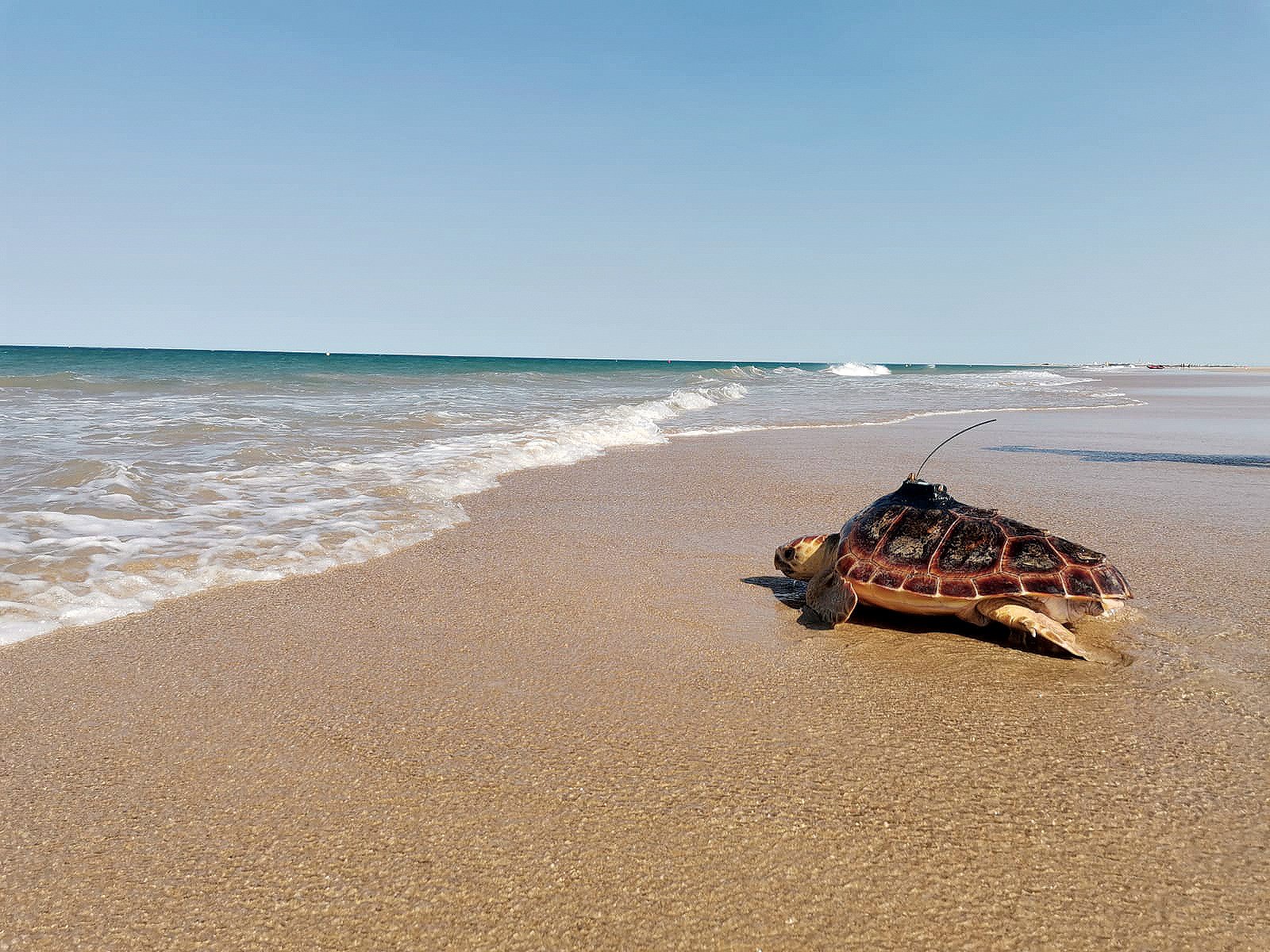Fishers and Turtles Navigate the Same Waters
By Daniel González-Paredes, Patricio Peñalver-Duque, and Carolina Fernández-Maldonado
Crew members aboard the vessel El Minero hold the first loggerhead rescued as part of the S.O.S Caretta project. © HyT Association
S.O.S Caretta—Fishers for Biodiversity
At the frontier of two major bodies of water, Spain’s Iberian Peninsula protrudes southward to within 10 miles of North Africa at the Strait of Gibraltar, separating the Gulf of Cádiz (Atlantic) from the Alboran Sea (Mediterranean). Those contiguous bodies of water are key feeding areas for loggerhead turtles from two distinct subpopulations (also known as regional management units, or RMUs). And those same areas are important destinations for trawl and purse-seine fishers from the Spanish autonomous community of Andalusia. Interactions between turtles and fisheries are unavoidable; as a result of this unfortunate confluence, numerous bycaught and stranded turtles are found every year in those waters and along the region’s beaches.
Fisheries bycatch is one of the greatest threats to sea turtles, and it is considered a primary driver of sea turtle population decline worldwide. Although measures to reduce bycatch have been successfully implemented in many places, large numbers of turtles continue to be caught or killed in fishing gear, which makes a solution to this problem a global imperative. In fact, conservationists and fishers worldwide are seeking solutions, and among those is S.O.S Caretta, a project that was launched by Asociación Hombre y Territorio to address the challenge of bycatch and to reduce turtle mortality in loggerhead foraging grounds on the Andalusian coast.
Fishers Become First Responders
Sea turtles that are accidentally caught by fishers are often still alive, but they may be stressed, tired, or injured to varying degrees; if released in a weakened state, such animals can die. But it has been demonstrated that administering first-aid to bycaught turtles promptly after their capture can increase their chances of survival and buy them time until they can receive proper veterinary care back in port.
Therefore, collaborating with fishers is the key to saving the lives of countless turtles. But collaboration is not always easy, and it requires building strong alliances between conservationists and fisheries to jointly develop and enforce action plans. The S.O.S Caretta project began by hosting open dialogues to discuss the priorities and concerns of all stakeholders and to create a collaborative framework for conservation action. Fishers were then taught best practices for disentangling turtles from their gear and were trained in simple actions that sustain the animals until their arrival in port.
The training also instructs fishers in how to notify rangers from the Regional Government of Andalusia (Junta de Andalucía) so they receive the rescued turtles upon arrival and can transfer the turtles to the Center for the Management of Marine Environmental Resources of Andalusia (CEGMA). At present, S.O.S Caretta provides technical support and training to fishing guilds that represent around 300 trawl and purse-seine vessels from four main Andalusian fishing ports.
Success Breeds Enthusiasm
Adelina, a loggerhead turtle rescued by the S.O.S Caretta project, heads back to sea with a satellite tracker on its carapace. © HyT Association
From the start of S.O.S Caretta in 2020, a few fishers showed a great deal of interest in the program and were among the first to rescue bycaught turtles while using their training. Each time an animal arrived at port, the whole guild would celebrate those heroes, thereby encouraging others to repeat the act. Enthusiasm spread, and in less than a year, 36 loggerhead turtles had been rescued at sea, transferred to CEGMA for rehabilitation, and then successfully released back to the wild after a favorable veterinarian health assessment. Three of those patients were also fitted with satellite tracking devices that generated novel information about habitat use and migratory patterns to and from Andalusian waters. Curiously, each of the three turtles went in different directions: Bonanza swam northwards to the North Atlantic Gyre, while Adelina traveled to the temperate waters around the Azores, and Miriam remained in the Golfo de Cadiz.
Ways to Build Awareness for the Future
S.O.S Caretta believes that long-term success with the fisheries guilds must be closely linked to increased environmental awareness. Thus, all the project actions conducted have been supported by a strong awareness campaign, which includes the implementation of educational programs at local schools that have reached more than 2,000 people, as well as public releases of recovered turtles. At the releases, fishers’ families come together to affirm their deeply rooted pledge: Con el esfuerzo de todos, podemos salvar las tortugas marinas (Together, we can save sea turtles).
S.O.S Caretta’s mission is to empower fishers to reduce bycatch impacts on sea turtles. For its success in this endeavor, the organization was recognized with an award from the Spanish Coast Guard for its contribution to the United Nations Sustainable Development Goal to “conserve and sustainably use the oceans, seas and marine resources for sustainable development.” S.O.S Caretta represents a sizable step forward in efforts to involve fishers in marine turtle conservation and to change public perceptions of the fisheries as important players in ocean conservation.
S.O.S Caretta is grateful to the Fundación Cepsa for its support, to the numerous governmental agencies and partner organizations that have cooperated in this important work, and especially to the dozens of Andalusian fishers and their families, without whom this work would not be possible. To learn more please visit www.soscaretta.org.
This article originally appeared in SWOT Report, vol. 18 (2023). Click here to download the complete article as a PDF.


